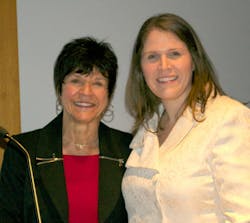Dental hygienists, nurses discuss collaboration on oral systemic health
Jacquelyn Fried, MS, RDH, was the conference co-chair with Shannon Idzik, DNP, MS, CRNP.
Several health professions discussed professional collaboration on oral and systemic health during a conference at the University of Maryland on Dec. 10. The conference brought together 120 dental hygienists, nurses, and other health educators to discuss increased collaboration between the dental hygiene and nursing professions.
The Baltimore conference, titled “Oral Systemic Link: Creating Collaborative Initiatives,” emphasized methods that dental and medical professions could share in improving education, research, and practice modalities.
Related articles
European and American periodontal thought leaders collaborate to advance the dental science behind the perio-systemic link
Topical antioxidants: an emerging indication of oral disease
And you thought dental plaque was bad: preventing evolution of biofilms
Speakers reinforced oral health connections with diabetes, osteoporosis, anxiety, tension, depression, earaches, eating disorders, poor nutrition, and some cancers.
Jacquelyn Fried, MS, RDH, director of interprofessional initiatives at the University of Maryland School of Dentistry and the conference’s co-chair, said, "The oral-systemic link highlights commonalities between nursing, dental hygiene, and other health professions. These commonalities lead to collaborative models, interprofessional models. Why? Because of shared patient outcomes that promote wellness and the desire for interprofessional education that develops well-rounded providers.”
Dr. Mark Reynolds, chairman of the university’s periodontics department, added, "Inflammation is the tie that binds … [bacterial infections] are not only tissue invasive, but cell invasive and found throughout the body … the treatment of oral disease, particularly periodontal disease, reduces hospitalization costs."
JoAnn Gurenlian, RDH, PhD, a columnist for RDH magazine and president-elect of the International Federation of Dental Hygienists, participated in the conference. "The whole point of what we want to accomplish [in interprofessional collaboration] is to look at the whole person. Oral health is health, and we forget that. In nursing, in physical therapy, in speech pathology, in medicine, in any other [health] group, oral health is [currently] rarely thought of. And how could that be so? Students get only an hour of oral health education in their curriculum."
Dr. Jay Perman, president of the University of Maryland and a pediatric gastroenterologist, said the conference was an “important event on the link of oral and systemic health highlights trends of working together to help reform our health care delivery system rather than working alone in our individual professions. It is a terribly important collaboration that needs to be developed."
Judith Haber, PhD, APRN, FAAN, the Ursula Springer Leadership Professor in Nursing and associate dean of graduate programs at the New York University College of Nursing, outlined dental hygiene/dental/nursing educational opportunities, such as nursing students conducting an oral health history and recognizing normal vs. pathological variations of oral structures. A side-by-side consultation project with interprofessional students on comprehensive oral-systemic patient assessments and referrals for systemic health risks would be another innovation, said Haber, who also discussed collaborative innovations in pediatrics and summer research projects.
"There were multiple dynamics in play at this conference," said Kathryn Montgomery, PhD, RN, NEA-BC, associate dean for strategic partnerships and initiatives and associate professor at the University of Maryland School of Nursing. "There was clinical content, there were practice issues and interprofessional education, as well as a new conference-participation approach with full engagement of participants in 'active learning.'
An educational grant from the Colgate-Palmolive Company supported the conference.

